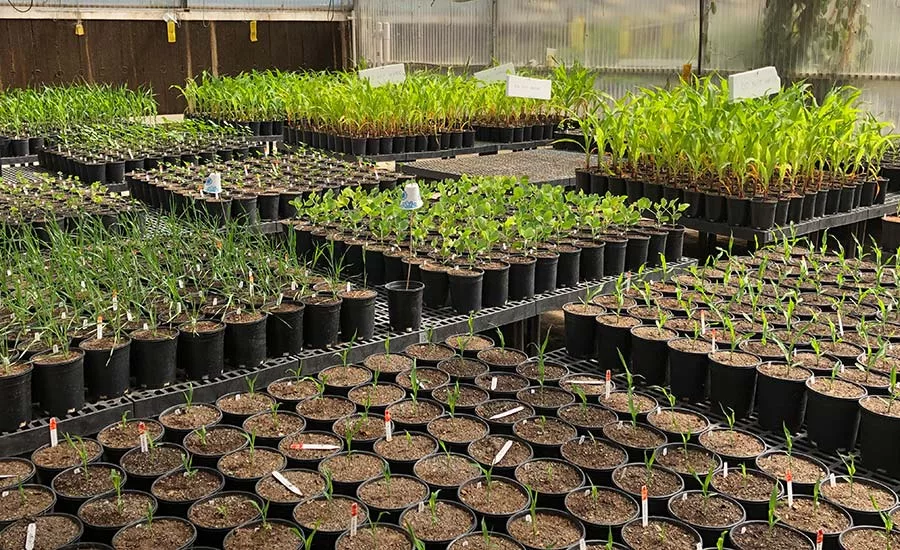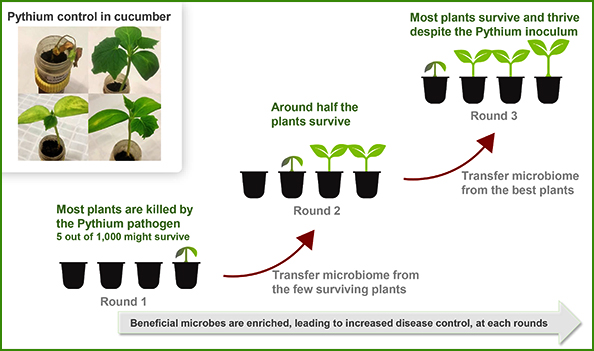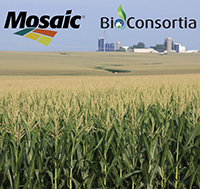Pollution control
Novel method to provide nitrogen to plants without nitrate pollution
What if corn and wheat could create most of their own nitrogen like soy and peas?

In its test greenhouse BioConsortia runs analyses on corn to discover nitrogen-fixing bacteria specific to corn that together—the corn and bacteria—in a symbiotic relationship can grab atmospheric nitrogen and turn it into ammonia, which the plant needs to thrive. Source: BioConsortia
Having grown up on a poultry farm, one thing we had plenty of was nitrogen-rich manure, which our crop farmer was only too happy to use on our corn and wheat crops. Why? It saved money on inputs. Using manure every year pretty much obviated the need for large quantities of nitrogen-based fertilizers, since our corn and wheat got their nitrogen in the form of ammonia from the manure every year. The appearance of a soy crop in our field was a rare occasion, with the primary need to alternate once in awhile to keep down corn- or wheat-specific diseases. One thing for sure, we weren’t contributing to excess nitrate runoffs into nearby creeks and water bodies, because there wasn’t a need to over-fertilize with chemicals.
While some farms today are trying to get off the mono-crop bandwagon and rotate crops, many large farms still tend to grow corn or wheat in the same field every year, requiring a lot of nitrogen-based fertilizer. Rotating corn and soy, of course will help the soil and decrease the need for nitrogen-based fertilizers. In fact soy works with nitrogen-fixing bacteria to pull nitrogen out of the air and provide the nutrients (ammonia) that the soy plant requires—a true symbiotic relationship between soy and bacteria.
But what if—like soy, peas and other legumes—corn and wheat could have their own symbiotic relationship with soil bacteria that could pull nitrogen out of the air and fix it in such a way that corn and wheat plants could have nitrogen without the farmer inefficiently having to dump loads of nitrogen gas or nitrate fertilizers into the ground?
This is what a relatively new research company named BioConsortia set out to do. Not only is BioConsortia developing a system for corn and wheat to produce their own nitrogen input through a symbiotic relationship with—let me say, “hand-picked”—nitrogen-fixing bacteria, but the company has also been working on developing highly effective, non-chemical bio-pesticides.
I spoke with Marcus Meadows-Smith, CEO of BioConsortia, to get a better picture of its mission to give corn and wheat an opportunity to develop their own supply of nitrogen—just as soy and peas do. Meadows-Smith hails from the countryside in England where his family had a small farm. He was formerly CEO of Agra-Quest and head of Biologics for Bayer CropScience.
 |
| Marcus Meadows-Smith, CEO of ConSortia |
How the process works
The proprietary, patented process—Advanced Microbial Selection (AMS)—that Meadows-Smith describes sounds a little like natural selection, or somewhat like the same process my dad used to select seeds for garden produce—save the seeds from the most healthy plants to raise the following year. But, of course, AMS is a lot more complex.
“We start like plant breeders. We don’t isolate microbes from the environment," says Meadows-Smith. “What we do is grow plants in a wide range of soils.”
He then describes how this process works through an example for finding plants that can survive the destructive parasitic Pythium pathogen, which is typically found in the soil; but for purposes of experimentation, it is added to the test soil to see which plants naturally survive this usually deadly disease.
 |
| In the Pythium experiment, plants are selected based on which survive, and the microbiome from the surviving plants is used with the surviving plants, and this process is repeated. A similar method is used to find nitrogen fixing microbes for corn and wheat. Source: BioConsortia |
“Pythium is very destructive. It kills young seedlings,” says Meadows-Smith. “So when we plant a thousand seeds, we may only find half a dozen that survive and sprout. What we do is take all of the plant microbiome of those plants that survive, put them on the next round of seeds, and then we add the pythium disease again, but the plant now is protected by the microbiome that came up with those seeds.
“When we go to the next round, we will see that almost all of the plants survive because what we’ve done is we’ve evolved the plant’s microbiome, and we’ve accumulated the beneficial microbes that protect the plant.”
Apply the same process to discover nitrogen fixing bacteria for corn
“The way we discovered our nitrogen fixing microbe is we grew a thousand seeds on the soil with no nitrogen—or very low levels of nitrogen—and the first round, most of those corn seedlings just petered out,” says Meadows-Smith. “They couldn’t grow in the absence of nitrogen. But the few that had, we were able to recruit naturally occurring microbes from the background soil, which fix atmospheric nitrogen. So there are certain classes of microbes that can take nitrogen from the air and convert it into ammonia that the plant can then use for growth.”
Outside of water, nitrogen is the biggest driver of crop yield and growth. Without nitrogen, a plant will look very sickly, says Meadows-Smith. “So we did the same interesting process to discover a natural set of microbes that would associate with corn and wheat plants and fix atmospheric nitrogen.”
Now as you probably know, if you grow soybeans or peas, most farmers supply just a fraction of the nitrogen fertilizers that they apply to a corn crop, says Meadows-Smith. That’s because through the millennia, there has evolved a symbiotic relationship between these nitrogen fixing microbes and the peas and the bean plants. But that symbiotic relationship doesn’t exist for monocotyledon crops (corn and wheat). “What we have done is go out and discover microbes that colonize the corn and wheat plants and will fix atmospheric nitrogen.”
Determining the efficacy of the process
Meadows-Smith and his researchers wanted to learn how and how frequently the nitrogen-fixing microbes were colonizing the corn or wheat plant. They tagged the microbes with a fluorescent protein, so they’re detectable under the microscope as they fluoresces green, yellow or red—depending on the protein used. So the next step was to determine if the microbes were colonizing wheat and corn every time, and if they were, what soil types, pHs and temperatures were ideal for growth. If the conditions tolerated were too narrow, then the microbes might work in one growth field but not another, which isn’t good for varying agricultural soil and climatic conditions.
What the researchers found was the microbe grows in soils with a pH from 5 to 9, and in temperatures from 4 to 25°C (roughly 39 to 77°F). In cold soils, the microbe doesn’t like acidic conditions, so the researchers found another microbe that likes cold, acidic soils, and put them together.
When/how do you apply the microbes?
While biological pesticides can be applied to crops at any time (and even fruiting), the nitrogen-fixing microbes can be applied as a seed treatment or put in the furrow at the time of planting, says Meadows-Smith. With high-value crops, it can actually be applied through a drip irrigation system. Applying to the seed is very cost-effective because as the seed germinates, the microbes are actually fed by the young seedling. The microbes then colonize the plant and grow with the plant. So, the microbes are actually manufactured in situ at the plant and microbes grow together.
BioConsortia is also developing nematicide products. Nematodes (roundworms) typically decrease crop output. But microbes on the seed grow with the root system and protect it from invasion by nematodes, says Meadows-Smith. Therefore, the crop above ground is healthy. The ultimate measure as to whether the system is working is yield. A higher yield indicates success. It’s very easy to know if a plant is nitrogen-stressed; its color and growth are good indicators, but like the nematicides it is higher yields, while reducing fertilizer inputs, that is the ultimate indicator of success.
The process is efficient as it is with naturally nitrogen-fixing plants such as soy and legumes. “There is an estimate that 50% of the nitrogen fertilizer applied by growers is actually lost to the environment,” says Meadows-Smith. It is lost to the atmosphere and leeches into groundwaters, and runoffs into streams—creating dead zones in lakes and oceans where fish and crustacean can’t live.
BioConsortia’s partnership with Mosaic
 |
| A “natural partnership,” BioConsortia and Mosaic offer together a complete plant fertilizer system. Source: BioConsortia |
“In our product offerings, we’re not looking to replace all of the synthetic nitrogen fertilizers,” says Meadows-Smith. “We want to reduce the initial fertilizer application by about 25-30% as our first target.” Meadows-Smith saw the value in teaming up with a fertilizer company, but it had to be where BioConsortia’s product would complement a fertilizer company.
This was the primary reason BioConsortia teamed up with Mosaic at the end of last year. Mosaic actually doesn’t have a nitrogen product, but is a major supplier of phosphate and potassium fertilizers, so the partnership made sense.
Mosaic and BioConsortia are collaborating to develop beneficial microbial products designed to reduce the amount of conventional nitrogen fertilizer application, while increasing crop yields and grower revenue. The Mosaic/BioConsortia partnership is aimed at developing yield enhancing in-furrow and seed treatment products that can be used either standalone or in combination with conventional chemistries and fertilizers.
Significantly reducing the use of conventional nitrogen fertilizer requires innovation not yet seen in currently available biological products. “However, BioConsortia has already discovered naturally-occurring spore forming microbes capable of fixing atmospheric nitrogen and colonizing corn, wheat and other non-leguminous plants,” says Meadows-Smith. “With targeted traditional and cutting-edge strain improvement and gene editing technologies, we will develop natural and improved strain microbial products that will increase crop yields while maintaining or reducing nitrogen fertilizer inputs.
“We are excited to partner with Mosaic, a proven leader in agriculture,” says Meadows-Smith. “We believe their established expertise and market access in the field of fertilizers and crop nutrition is the perfect route to market for ground breaking nitrogen-fixing microbial products. Our microbes will complement and expand Mosaic’s established crop nutrient business to the benefit of growers throughout the Americas.”
Mosaic will have exclusive rights to the nitrogen fixing technology for core row crops in the Americas, initially focused on corn, wheat, cotton and sugarcane. BioConsortia will retain all rights to the technology for fruit, vegetable, turf and ornamental crops and for all uses outside of the Americas. Under the agreement BioConsortia will receive an upfront payment and research funding, as well as royalties. Additional details about the agreement were not disclosed.
For inquiries and further information, please contact info@bioconsortia.com or visit BioConsortia online.
About Marcus Meadows-Smith
Marcus Meadows-Smith is CEO of BioConsortia, Inc., an innovative microbial company developing consortia for improving plant traits and increasing crop yields. The company’s innovative R&D technology platform uses directed selection to identify teams of microbes that influence the expression of beneficial traits in crops. BioConsortia is developing highly effective multi-microbe solutions with superior efficacy and consistency.
Prior to BioConsortia, Meadows-Smith helped pioneer the adoption and expansion of microbial solutions into mainstream agriculture. As CEO of AgraQuest, he led the strategic refocusing and transformation of the company to a position of market leadership, resulting in the sale to Bayer CropScience for nearly $500 million. Following the acquisition, Meadows-Smith was the Head of Biologics for Bayer CropScience. Earlier in his career, he worked for Sumitomo Corporation and had a 14 year career at Chemtura, ultimately becoming Executive Vice-President for a $2 billion portfolio of businesses: crop protection, consumer products and plastics additives.
Marcus Meadows-Smith has a degree in Biological Science, Genetics from Birmingham University in the UK. He is passionate about farming and the environment and runs a small, sustainable farm and vineyard with his wife where they produce wine, lavender, fruit, and olive oil.
Looking for a reprint of this article?
From high-res PDFs to custom plaques, order your copy today!









